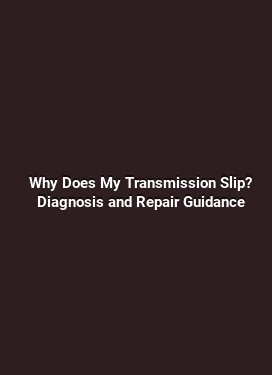ATF Maintenance: When Should You Flush Your Automatic Transmission?
Automatic transmissions rely on a precise balance of hydraulic pressure, friction materials, and a carefully formulated automatic transmission fluid (ATF) to deliver smooth shifting, reliable torque conversion, and long service life. Understanding when to flush ATF, how to perform it correctly, and what to expect from different maintenance approaches can prevent costly repairs and keep the drivetrain performing at its best. This article explores practical guidance, real-world scenarios, and decision-making factors that help drivers optimize transmission health without overdoing maintenance or risking unnecessary service.
Understanding ATF and the Concept of a Fluid Flush

ATF is more than just a lubricant. It provides cooling, hydraulic pressure, lubrication for moving components, and a medium for transmission electronics to sense temperature and pressure. Over time, ATF degrades due to heat, friction, and contaminants such as metal shavings, clutch dust, and environmental particles. A flush broadly refers to a service that replaces most or all of the old ATF with new fluid in both the transmission valve body and cooler loops, often using a machine that circulates new fluid through the system while removing used fluid. The alternative approach, a drain-and-fill or simple pan drain, replaces only a portion of the fluid and may not remove all contaminants attached to internal surfaces or in the cooler lines.
There are several approaches to ATF maintenance, and each has its place depending on the vehicle, transmission type, and maintenance history. A well-planned strategy considers the age, mileage, service history, and symptoms the driver is experiencing, rather than adhering to a rigid schedule. The decision to flush typically weighs potential benefits—such as improved shifting, cooler temperatures, and contaminant removal—against risks like dislodging debris that could clog small passages in older transmissions. Understanding these trade-offs helps you make an informed choice.
Key Indicators That You May Benefit from a Flush
While many drivers rely on manufacturer intervals, certain signs suggest that a flush, or a more thorough service, could be advantageous. Recognizing symptoms early can prevent transmission wear from escalating and reduce the likelihood of sudden failures.
Shifting Anomalies and Slippage

If shifting feels unbalanced—such as hard or delayed upshifts, flare between gears, or slipping that seems to occur under load—metallic debris from wear and degraded ATF could be contributing to valve body sticking or clogs. A flush can help restore hydraulic flow and reduce inner friction that causes these symptoms. However, it is essential to diagnose correctly; some shifting issues may stem from the valve body, solenoids, or band/clutch wear that won’t be resolved by fluid replacement alone.
Overheating Symptoms
ATF temperature trends influence wear and oxidation. If the transmission tends to run hotter than normal, the ATF may degrade faster, losing cooling properties and lubrication effectiveness. A flush can introduce cooler, fresher fluid that aids heat dissipation and extends the fluid’s useful life. In extreme cases, an overheating condition may require additional cooling system checks, such as radiator or cooler line integrity, to prevent recurring heat load.
Contaminants and Odor
Strong burnt smells or visible dark, gritty fluid can indicate oxidation and the presence of contaminants. When ATF appears dark or has a burnt odor, a flush offers a means to remove degraded fluid and debris that may be circulating within the valve body. Still, persistent contamination often signals an underlying mechanical issue that warrants careful inspection of seals, pump wear, or external cooling components.
Mileage, Age, and Service History
For high-mileage vehicles with limited service history, a controlled flush using appropriate equipment can be beneficial, especially if the fluid has never been replaced or only partially replaced. In such cases, a professional assessment helps determine which method best suits the transmission design and fluid type. In some transmissions, frequent flushes can diminish bearing clearances or soaps, so a targeted approach—drain-and-fill with scheduled broad intervals—may be more appropriate.
Flush vs. Drain-and-Fill: Choosing the Right Method
Understanding the differences between a complete fluid flush and a traditional drain-and-fill is essential for setting expectations and selecting the correct service plan. The two approaches have distinct implications for cleanliness, cost, and potential risks.
Complete Flush Procedure
A flush typically uses a machine-based process to push new ATF through the transmission’s cooling system and valve body while simultaneously extracting old fluid. This method aims to replace nearly 100% of the circulating fluid, including fluid in cooler lines and the torque converter. Benefits include improved hydraulic response, quicker cooler recovery after a load, and better removal of contaminants that accumulate in narrow passages. Risks involve dislodging debris that might temporarily clog or irritate the valve body and the requirement for a system-compatible flush machine and fluid type. A flush is not universally recommended for every transmission; some models, particularly those with limited clearances or sensitive valve bodies, may benefit from a more conservative approach.
Drain-and-Fill or Pan Drain
In a drain-and-fill, the technician drains a portion of the ATF from the pan and replaces it with fresh fluid, often repeating the process. This method is less aggressive and reduces the risk of introducing debris into delicate passages. It also tends to be quicker and cheaper. The downside is that some contaminants remain embedded in the torque converter and internal galleries, so the overall cleanliness and cooling performance may not reach the same level as a full flush. For many drivers, a drain-and-fill at appropriate intervals, combined with regular fluid level checks, provides a reliable maintenance solution with a lower risk profile.
Selecting the Right ATF and Compatibility Considerations
Fluid selection is a critical component of transmission longevity. Using the manufacturer-recommended ATF formulation—not just the viscosity but also the additive package—helps ensure proper clutch operation, seal compatibility, and hydraulic performance. Some modern transmissions specify a universal Dexron or Mercon fluid, while others require a proprietary or semi-synthetic formulation that is tuned for the transmission’s valve body calibration. Using the wrong ATF can lead to slipping, harsh shifts, or increased wear. When in doubt, consult the owner’s manual, the dealership service bulletin, or a qualified technician who can verify the exact specification for your vehicle’s year, make, and model.
In addition to compatibility, consider fluid quality and contamination risk. High-quality fluids contain detergents that help prevent sludge formation and keep the valve body passages clear. If a flush is performed, ensuring that the replacement fluid meets or exceeds OEM specifications is essential. Some flush machines offer a flow rate and temperature control to avoid overheating the transmission during the procedure, which can otherwise accelerate oxidation and wear.
How to Prepare for a Transmission Flush
Preparation minimizes risk and ensures a smoother service experience. A few practical steps help technicians execute a flush reliably and help you assess the outcomes post-service.
Pre-Service Diagnostics
Before initiating a flush, a technician should perform a diagnostic evaluation that includes reading transmission fault codes, checking fluid condition, assessing the transmission’s electronic controls, and verifying fluid level with the engine at normal operating temperature. This baseline helps determine whether a flush is likely to address the observed symptoms or if alternative repairs are required. Also, measuring line pressure and conducting a visual inspection of the cooler lines helps identify potential leaks or restrictions that could affect the efficacy of the flush.
Fluid Condition and Quantity Assessment
Color, odor, and viscosity provide quick cues about fluid health. ATF is typically a bright red or amber color when fresh; dark brown or burnt smelling fluid indicates oxidation and contamination. The quantity of used fluid removed during a flush is an indicator of how aggressive the process is and can inform whether additional steps, such as filter replacement or a full valve body service, might be beneficial. Ensuring the transmission cooler and lines are free of obstructions is essential, as clogged coolers can cause rapid fluid degradation and overheating.
Post-Service Verification
After flushing, a comprehensive verification should follow. This includes rechecking the ATF level at recommended temperature, verifying that the transmission shifts smoothly across all gears, and confirming there are no new leaks. A brief road test that includes pulling light loads and modulating gears can help confirm that the system operates within normal parameters. If any abnormal condition arises, a follow-up inspection may be required to address residual debris or sensor-related issues that could manifest after the fluid change.
Maintenance best practices for Transmission Health
Beyond the decision to flush, adopting consistent maintenance habits helps extend transmission life and maintain performance. A proactive approach considers driving conditions, climate, and load patterns that influence ATF degradation rates.
Regular Fluid Level Checks
ATF levels should be checked while the engine is warm and the vehicle on level ground. Low fluid levels can cause insufficient hydraulic pressure, leading to degraded shifting and potential slippage. Knowing the correct dipstick technique or electronic level reading for your model helps avoid misinterpretation and unnecessary top-offs with the wrong fluid type.
Fluid Condition Monitoring
Even with a well-managed schedule, monitoring the condition of ATF over time is prudent. If the fluid exhibits a persistent burnt odor, unusual color, or foaming, it signals accelerated degradation or a cooling system issue that warrants attention. Proactive monitoring reduces the likelihood of unexpected transmission failures and helps tailor maintenance to usage patterns and environmental conditions.
Cooling System Integration
Cooling efficiency directly impacts ATF life. A damaged radiator, clogged cooler lines, or a compromised cooler can cause the transmission to overheat, accelerating fluid breakdown. Periodic inspection of the transmission cooler, radiator, and related hoses ensures the cooling circuit functions as intended. In some installations, the cooler is integrated with the radiator, so a pressure test can reveal hidden leaks that may not be obvious from a visual check alone.
Driving Habits and Load Management
Aggressive driving, frequent towing, or heavy payloads impose higher thermal loads on the transmission. Adapting driving behavior—such as gradual shifting, using manual shift modes when appropriate, and allowing the transmission to acclimate during long highway drives—can reduce thermal strain and extend fluid life. For vehicles used in demanding conditions, a more frequent maintenance cadence may be warranted to preserve performance and reliability.
Common Myths and Realistic Expectations
Several misconceptions surround ATF maintenance. Separating fact from fiction helps drivers make informed decisions and avoid unnecessary procedures. For example, some people believe that more frequent flushes always yield better results, but excessive fluid changes can disturb delicate tolerances or dislodge deposits that the system relies on to regulate pressure. Others assume that new ATF is a cure-all for shifting problems; however, many issues stem from mechanical wear, sensor faults, or control modules that require targeted repair beyond fluid replacement. A well-structured maintenance plan combines timely fluid changes with diagnostic checks and, when needed, component service to address root causes rather than symptoms alone.
Trend and Semantic Context in Transmission Care
In modern drivetrain maintenance, terms related to fluid dynamics, thermal management, and materials science influence maintenance choices. When evaluating ATF service, drivers should consider not only the color and smell of the fluid but also how the transmission’s electronic controls respond to changing fluid properties. The emphasis on coolant efficiency, seal compatibility, and friction material wear reflects a broader shift toward predictive maintenance that leverages service history, mileage patterns, and real-world driving data to optimize upkeep. This holistic view supports a resilient drivetrain strategy that aligns with the evolving expectations of vehicle performance, reliability, and long-term ownership costs.
Practical Takeaways for Vehicle Owners
- Follow the manufacturer’s ATF specifications for fluid type and replacement intervals, but tailor the schedule to driving conditions and service history.
- Consider a full flush if the transmission has high mileage, a contested service history, or visible contaminants in the fluid, provided the transmission design supports it and professionals perform it with proper equipment.
- For lower-risk maintenance, a well-timed drain-and-fill at regular intervals can maintain hydraulic performance without the higher risk profile of a flush.
- Always perform a thorough diagnostic and post-service verification to ensure the decision to flush was appropriate and the transmission operates correctly afterward.
Conclusion: Making Informed, Practical Decisions
Effective ATF maintenance blends diagnostic insight with informed choices about flushing, drain-and-fill, and fluid specifications. By recognizing symptoms, understanding the differences between service methods, and adhering to compatibility guidelines, vehicle owners can optimize transmission performance, extend service life, and reduce the likelihood of unexpected failures. The goal is a smooth, dependable drivetrain that responds precisely to driver input under a wide range of operating conditions.






